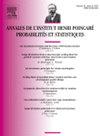Pólya密度的树后验分布
IF 1.6
2区 数学
Q2 STATISTICS & PROBABILITY
Annales De L Institut Henri Poincare-probabilites Et Statistiques
Pub Date : 2017-11-01
DOI:10.1214/16-AIHP784
引用次数: 28
摘要
. Pólya树形成了贝叶斯非参数中常用的一类先验分布。对于某些参数的选择,Pólya树是密度函数的先验分布。本文对密度估计模型中的诱导后验分布进行了频域分析。我们从最大损失的角度研究了Pólya树后密度的收缩率,并研究了极限形状分布。建立了后验累积分布函数的非参数Bernstein-von Mises定理和Bayesian Donsker定理。的简历。Pólya的树木组成了一类先验的、利用的、薪金和非薪金。倒一些精选的parparires, les arbres de Pólya industrial des lois densit本文章由计算机程序翻译,如有差异,请以英文原文为准。
Pólya tree posterior distributions on densities
. Pólya trees form a popular class of prior distributions used in Bayesian nonparametrics. For some choice of parameters, Pólya trees are prior distributions on density functions. In this paper we carry out a frequentist analysis of the induced posterior distributions in the density estimation model. We investigate the contraction rate of Pólya tree posterior densities in terms of the supremum loss and study the limiting shape distribution. A nonparametric Bernstein–von Mises theorem is established, as well as a Bayesian Donsker theorem for the posterior cumulative distribution function. Résumé. Les arbres de Pólya constituent une classe de lois a priori très utilisée en bayésien non-paramétrique. Pour certains choix de paramètres, les arbres de Pólya induisent des lois à densité. Nous menons une analyse fréquentiste des lois a posteriori bayésiennes correspondantes dans le modèle d’estimation de densité. La concentration a posteriori des densités–arbre de Pólya est étudiée en terme de la norme–sup et nous déterminons la loi a posteriori limite après renormalisation. Un théorème de Bernstein– von Mises non-paramétrique est établi, ainsi qu’un théorème de Donsker bayésien pour la fonction de répartition a posteriori.
求助全文
通过发布文献求助,成功后即可免费获取论文全文。
去求助
来源期刊
CiteScore
2.70
自引率
0.00%
发文量
85
审稿时长
6-12 weeks
期刊介绍:
The Probability and Statistics section of the Annales de l’Institut Henri Poincaré is an international journal which publishes high quality research papers. The journal deals with all aspects of modern probability theory and mathematical statistics, as well as with their applications.

 求助内容:
求助内容: 应助结果提醒方式:
应助结果提醒方式:


